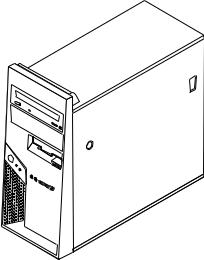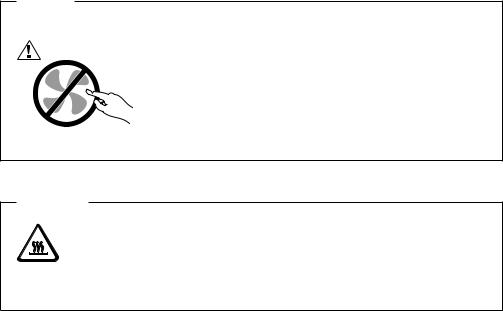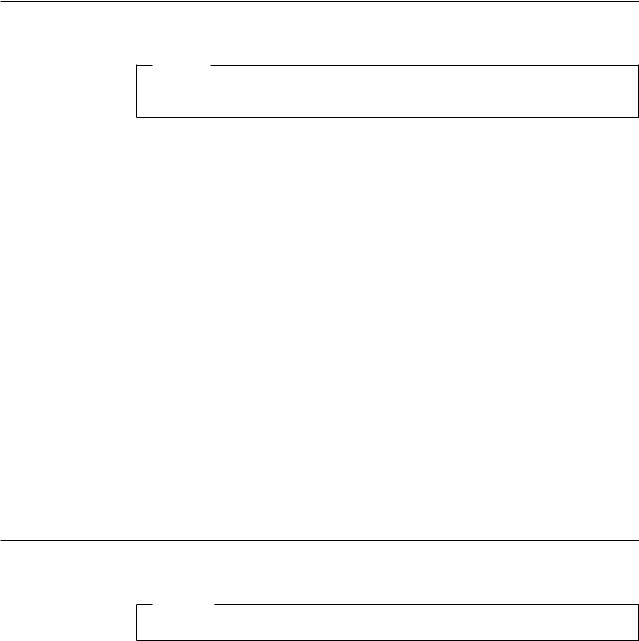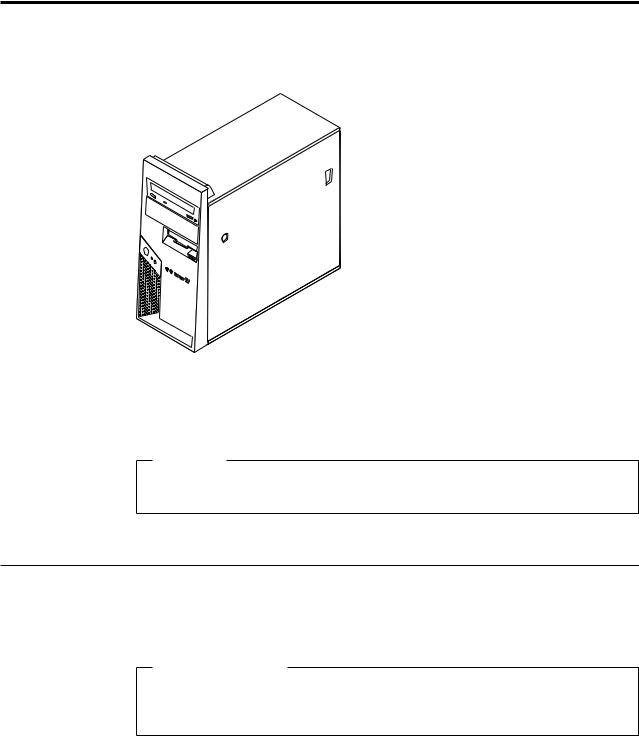IBM 8122, 8138, 8137, 8123, 8131 User Manual

User Guide
Types 8131, 8137, 8138
Types 8122, 8123, 8124
User Guide
Types 8131, 8137, 8138
Types 8122, 8123, 8124

Note
Before using this information and the product it supports, be sure to read the “Important safety information” on page v and Appendix D, “Notices,” on page 43.
Third Edition (May 2006)
© Copyright International Business Machines Corporation 2006. All rights reserved.
US Government Users Restricted Rights – Use, duplication or disclosure restricted by GSA ADP Schedule Contract with IBM Corp.

Contents
Important safety information . . . . |
. |
. v |
Changing the battery . . . . . . . . . . |
. |
23 |
||
Conditions that require immediate action . . . |
. |
. v |
Erasing a lost or forgotten password (clearing |
|
|
||
General safety guidelines . . . . . . . . |
. |
. vi |
CMOS) . . . . . . . . . . . . . . . |
. |
24 |
||
Service . . . . . . . . . . . . . |
. |
. vi |
Replacing the cover and connecting the cables. . |
. |
25 |
||
Power cords and power adapters . . . . . . vii |
Chapter 2. Using the Setup Utility |
|
|
||||
Extension cords and related devices . . . |
. |
. vii |
|
|
|||
Plugs and outlets . . . . . . . . . |
. |
. viii |
program . . . . . . . . . . . . . |
. |
27 |
||
Batteries . . . . . . . . . . . . . |
. viii |
Starting the Setup Utility program. . . . . . |
. |
27 |
|||
Heat and product ventilation . . . . . |
. |
. ix |
|||||
Viewing and changing settings . . . . . . . |
. |
27 |
|||||
CD and DVD drive safety. . . . . . . |
. |
. ix |
|||||
Using passwords . . . . . . . . . . . |
. |
27 |
|||||
Additional safety information. . . . . . . |
. |
. x |
|||||
User Password . . . . . . . . . . . |
. |
27 |
|||||
Lithium battery notice . . . . . . . . . |
. |
. x |
|||||
Administrator Password . . . . . . . . |
. |
28 |
|||||
Modem safety information . . . . . . . |
. |
. xi |
|||||
Setting, changing, and deleting a password . . . 28 |
|||||||
Laser compliance statement . . . . . . . |
. |
. xi |
|||||
Using Security Profile by Device . . . . . . |
. |
28 |
|||||
Power supply statement . . . . . . . . |
. |
. xii |
|||||
Selecting a startup device. . . . . . . . . |
. |
29 |
|||||
|
|
|
|
||||
Overview . . . . . . . . . . . . |
. xiii |
Selecting a temporary startup device . . . . |
. |
29 |
|||
Changing the startup sequence . . . . . . |
. |
29 |
|||||
Information resources. . . . . . . . . |
. |
. xiii |
Exiting from the Setup Utility program . . . . |
. |
29 |
||
Chapter 1. Installing options . . . . |
. |
. |
1 |
Appendix A. Updating system |
|
|
|
Features . . . . . . . . . . . . . . |
. |
. |
1 |
programs . . . . . . . . . . . . |
. |
31 |
|
Specifications . . . . . . . . . . . . |
. |
. |
4 |
System programs . . . . . . . . . . . |
. |
31 |
|
Available options . . . . . . . . . . . |
. |
. |
5 |
Updating (flashing) BIOS from a diskette or |
|
|
|
Tools required . . . . . . . . . . . . |
. |
. |
5 |
CD-ROM . . . . . . . . . . . . . |
. |
31 |
|
Handling static-sensitive devices. . . . . . |
. |
. 6 |
Updating (flashing) BIOS from your operating |
|
|
||
Installing external options . . . . . . . . |
. |
. |
6 |
system . . . . . . . . . . . . . . |
. |
31 |
|
Locating the connectors on the front of your |
|
|
|
Recovering from a POST/BIOS update failure . . |
. 32 |
||
computer . . . . . . . . . . . . |
. |
. |
7 |
|
|
|
|
Locating the connectors on the rear of your |
. |
. |
8 |
Appendix B. Cleaning the mouse . . |
. 33 |
||
computer . . . . . . . . . . . . |
Cleaning an optical mouse . . . . . . . . |
. |
33 |
||||
Obtaining device drivers . . . . . . . |
. |
. |
9 |
||||
Cleaning a mouse with a ball . . . . . . . |
. |
33 |
|||||
Removing the cover . . . . . . . . . |
. |
. |
10 |
||||
|
|
|
|||||
Locating components . . . . . . . . . |
. |
. |
11 |
Appendix C. Manual modem |
|
|
|
Identifying parts on the system board . . . |
. |
. 12 |
|
|
|||
commands . . . . . . . . . . . . |
. |
35 |
|||||
Installing memory . . . . . . . . . . |
. |
. |
13 |
||||
Installing adapters . . . . . . . . . . |
. |
. |
14 |
Basic AT commands . . . . . . . . . . |
. |
35 |
|
Installing internal drives . . . . . . . . |
. |
. |
15 |
Extended AT commands . . . . . . . . . |
. |
37 |
|
Drive specifications . . . . . . . . |
. |
. |
15 |
MNP/V.42/V.42bis/V.44 commands . . . . . |
. |
38 |
|
Installing a drive in bay 1 or bay 2 . . . |
. |
. |
17 |
Fax Class 1 commands . . . . . . . . . |
. |
39 |
|
Connecting drives . . . . . . . . . . |
. |
. |
19 |
Fax Class 2 commands . . . . . . . . . |
. |
39 |
|
Connecting the first optical drive . . . . |
. |
. |
19 |
Voice commands. . . . . . . . . . . . |
. |
40 |
|
Connecting an additional optical drive, or |
|
|
|
Appendix D. Notices . . . . . . . . |
. |
43 |
|
parallel ATA hard disk drive. . . . . . |
. |
. |
20 |
||||
Connecting a serial ATA hard disk drive. . |
. |
. |
20 |
Television output notice . . . . . . . . . |
. |
44 |
|
Installing security features . . . . . . . |
. |
. |
21 |
Trademarks . . . . . . . . . . . . . |
. |
44 |
|
Identifying security locks . . . . . . . |
. |
. |
21 |
|
|
|
|
Padlock. . . . . . . . . . . . . |
. |
. |
22 |
Index . . . . . . . . . . . . . . |
. |
45 |
|
Integrated cable lock . . . . . . . . |
. |
. |
23 |
|
|
|
|
Password protection . . . . . . . . |
. |
. |
23 |
|
|
|
|
© Copyright IBM Corp. 2006 |
iii |
iv User Guide

Important safety information
Note
Please read important safety information first.
This information can help you safely use your ThinkCentre® or ThinkPad® personal computer. Follow and retain all information included with your computer. The information in this document does not alter the terms of your purchase agreement or the Lenovo™ Statement of Limited Warranty.
Customer safety is important. Our products are developed to be safe and effective. However, personal computers are electronic devices. Power cords, power adapters, and other features can create potential safety risks that can result in physical injury or property damage, especially if misused. To reduce these risks, follow the instructions included with your product, observe all warnings on the product and in the operating instructions, and review the information included in this document carefully. By carefully following the information contained in this document and provided with your product, you can help protect yourself from hazards and create a safer computer work environment.
Note: This information includes references to power adapters and batteries. In addition to mobile personal computers, some products (such as speakers and monitors) ship with external power adapters. If you have such a product, this information applies to your product. In addition, your computer product may contain a coin-sized internal battery that provides power to your system clock even when the machine is unplugged, so the battery safety information applies to all computers.
Conditions that require immediate action
Products can become damaged due to misuse or neglect. Some product damage is serious enough that the product should not be used again until it has been inspected and, if necessary, repaired by an authorized servicer.
As with any electronic device, pay close attention to the product when it is turned on. On very rare occasions, you might notice an odor or see a puff of smoke or sparks vent from your machine. Or you might hear sounds like popping, cracking or hissing. These conditions might merely mean that an internal electronic component has failed in a safe and controlled manner. Or, they might indicate a potential safety issue. However, do not take risks or attempt to diagnose the situation yourself.
Frequently inspect your computer and its components for damage or wear or signs of danger. If you have any question about the condition of a component, do not use the product. Contact the Customer Support Center or the product manufacturer for instructions on how to inspect the product and have it repaired, if necessary.
In the unlikely event that you notice any of the conditions listed below, or if you have any safety concerns with your product, stop using the product and
© Copyright IBM Corp. 2006 |
v |

unplug it from the power source and telecommunication lines until you can speak to the Customer Support Center for further guidance. See “Information resources” on page xiii.
vPower cords, plugs, power adapters, extension cords, surge protectors, or power supplies that are cracked, broken or damaged.
vSigns of overheating, smoke, sparks or fire.
vDamage to a battery (such as cracks, dents, creases), discharge from a battery, or a buildup of foreign substances on the battery.
vA cracking, hissing or popping sound, or strong odor that comes from the product.
vSigns that liquid has been spilled or an object has fallen onto the computer product, the power cord or power adapter.
vThe computer product, the power cord or power adapter has been exposed to water.
vThe product has been dropped or damaged in any way.
vThe product does not operate normally when you follow the operating instructions.
Note: If you notice these conditions with a product (such as an extension cord) that is not manufactured for or by Lenovo, stop using that product until you can contact the product manufacturer for further instructions, or until you get a suitable replacement.
General safety guidelines
Always observe the following precautions to reduce the risk of injury and property damage.
Service
Do not attempt to service a product yourself unless instructed to do so by the Customer Support Center. Use only a service provider who is approved to repair your particular product.
Note: Some parts can be upgraded or replaced by the customer. These parts are referred to as Customer Replaceable Units, or CRUs. Lenovo expressly identifies CRUs as such, and provides documentation with instructions when it is appropriate for customers to replace those parts. You must closely follow all instructions when performing such replacements. Always make sure that the power is turned off and that the product is unplugged from any power source before you attempt the replacement. If you have any questions or concerns, contact the Customer Support Center.
Although there are no moving parts in your computer after the power cord has been disconnected, the following warnings are required for proper UL certification.
vi User Guide

Danger
Hazardous moving parts. Keep fingers and other body parts away.
Attention
Before replacing any CRUs, turn off the computer and wait three to five minutes to let the computer cool before opening the cover.
Power cords and power adapters
Use only the power cords and power adapters supplied by the product manufacturer.
Never wrap a power cord around the power adapter or other object. Doing so can stress the cord in ways that can cause the cord to fray, crack or crimp. This can present a safety hazard.
Always route power cords so that they will not be walked on, tripped over, or pinched by objects.
Protect the cord and power adapters from liquids. For instance, do not leave your cord or power adapter near sinks, tubs, toilets, or on floors that are cleaned with liquid cleansers. Liquids can cause a short circuit, particularly if the cord or power adapter has been stressed by misuse. Liquids can also cause gradual corrosion of the power cord terminals and/or the connector terminals on the adapter which can eventually result in overheating.
Always connect power cords and signal cables in the correct order and ensure that all power cord connectors are securely and completely plugged into receptacles.
Do not use any power adapter that shows corrosion at the ac input pins and/or shows signs of overheating (such as deformed plastic) at the ac input or anywhere on the power adapter.
Do not use any power cords where the electrical contacts on either end show signs of corrosion or overheating or where the power cord appears to have been damaged in any way.
Extension cords and related devices
Ensure that extension cords, surge protectors, uninterruptible power supplies, and power strips that you use are rated to handle the electrical requirements of the
Important safety information vii
product. Never overload these devices. If power strips are used, the load should not exceed the power strip input rating. Consult an electrician for more information if you have questions about power loads, power requirements, and input ratings.
Plugs and outlets
If a receptacle (power outlet) that you intend to use with your computer equipment appears to be damaged or corroded, do not use the outlet until it is replaced by a qualified electrician.
Do not bend or modify the plug. If the plug is damaged, contact the manufacturer to obtain a replacement.
Some products are equipped with a three-pronged plug. This plug fits only into a grounded electrical outlet. This is a safety feature. Do not defeat this safety feature by trying to insert it into a non-grounded outlet. If you cannot insert the plug into the outlet, contact an electrician for an approved outlet adapter or to replace the outlet with one that enables this safety feature. Never overload an electrical outlet. The overall system load should not exceed 80 percent of the branch circuit rating. Consult an electrician for more information if you have questions about power loads and branch circuit ratings.
Be sure that the power outlet you are using is properly wired, easily accessible, and located close to the equipment. Do not fully extend power cords in a way that will stress the cords.
Carefully connect and disconnect the equipment from the electrical outlet.
Batteries
All personal computers manufactured by Lenovo contain a non-rechargeable coin cell battery to provide power to the system clock. In addition many mobile products such as ThinkPad notebook PCs utilize a rechargeable battery pack to provide system power when in portable mode. Batteries supplied by Lenovo for use with your product have been tested for compatibility and should only be replaced with approved parts.
Never attempt to open or service any battery. Do not crush, puncture, or incinerate batteries or short circuit the metal contacts. Do not expose the battery to water or other liquids. Only recharge the battery pack strictly according to instructions included in the product documentation.
Battery abuse or mishandling can cause the battery to overheat, which can cause gasses or flame to “vent” from the battery pack or coin cell. If your battery is damaged, or if you notice any discharge from your battery or the buildup of foreign materials on the battery leads, stop using the battery and obtain a replacement from the battery manufacturer.
Batteries can degrade when they are left unused for long periods of time. For some rechargeable batteries (particularly Lithium Ion batteries), leaving a battery unused in a discharged state could increase the risk of a battery short circuit, which could shorten the life of the battery and can also pose a safety hazard. Do not let rechargeable Lithium-Ion batteries completely discharge or store these batteries in a discharged state.
viii User Guide
Heat and product ventilation
Computers generate heat when turned on and when batteries are charging. Notebook PCs can generate a significant amount of heat due to their compact size. Always follow these basic precautions:
vDo not leave the base of your computer in contact with your lap or any part of your body for an extended period when the computer is functioning or when the battery is charging. Your computer produces some heat during normal operation. Extended contact with the body could cause discomfort or, potentially, a skin burn.
vDo not operate your computer or charge the battery near flammable materials or in explosive environments.
vVentilation slots, fans and/or heat sinks are provided with the product for safety, comfort, and reliable operation. These features might inadvertently become blocked by placing the product on a bed, sofa, carpet, or other flexible surface. Never block, cover or disable these features.
You should inspect your desktop computer for dust accumulation at least once every three months. Before inspecting your computer, turn off the power and unplug the computer’s power cord from the electrical outlet; then remove any dust from vents and perforations in the bezel. If you notice external dust accumulation, you should also examine and remove dust from the inside of the computer including heat sink inlet fins, power supply vents, and fans. Always turn off and unplug the computer before opening the cover. If possible, avoid operating your computer within 2 feet of high-traffic areas. If you must operate your computer in or near a high-traffic area, you should inspect and, if necessary, clean your computer more frequently.
For your safety and to maintain optimum computer performance, always follow these basic precautions with your desktop computer:
vKeep the cover closed whenever the computer is plugged in.
vRegularly inspect the outside of the computer for dust accumulation.
vRemove dust from vents and any perforations in the bezel. More frequent cleanings might be required for computers in dusty or high-traffic areas.
vDo not block or restrict airflow into the front of the computer.
vDo not block the airflow vents on the back of the computer.
vDo not store or operate your computer inside furniture, as this might increase the risk of overheating.
vAirflow temperatures into the computer should not exceed 35° C (95° F).
vDo not use non-ThinkCentre air filtration devices.
CD and DVD drive safety
CD and DVD drives spin discs at a high speed. If a CD or DVD is cracked or otherwise physically damaged, it is possible for the disc to break apart or even shatter when the CD drive is in use. To protect against possible injury due to this situation, and to reduce the risk of damage to your machine, do the following:
vAlways store CD/DVD discs in their original packaging
vAlways store CD/DVD discs out of direct sunlight and away from direct heat sources
vRemove CD/DVD discs from the computer when not in use
vDo not bend or flex CD/DVD discs, or force them into the computer or their packaging
Important safety information |
ix |

vCheck CD/DVD discs for cracks before each use. Do not use cracked or damaged discs
Additional safety information
Danger
Electrical current from power, telephone, and communication cables is hazardous.
To avoid a shock hazard:
vDo not connect or disconnect any cables or perform installation, maintenance, or reconfiguration of this product during an electrical storm.
vConnect all power cords to a properly wired and grounded electrical outlet.
vConnect to properly wired outlets any equipment that will be attached to this product.
vWhen possible, use one hand only to connect or disconnect signal cables.
vNever turn on any equipment when there is evidence of fire, water, or structural damage.
vDisconnect the attached power cords, telecommunications systems, networks, and modems before you open the device covers, unless instructed otherwise in the installation and configuration procedures.
vConnect and disconnect cables as described in the following table when installing, moving, or opening covers on this product or attached devices.
To connect: |
To disconnect: |
||
1. |
Turn everything OFF. |
1. |
Turn everything OFF. |
2. |
First, attach all cables to devices. |
2. |
First, remove power cords from outlet. |
3. |
Attach signal cables to connectors. |
3. |
Remove signal cables from connectors. |
4. |
Attach power cords to outlet. |
4. |
Remove all cables from devices. |
5. |
Turn device ON. |
|
|
|
|
|
|
Lithium battery notice
Caution
Danger of explosion if battery is incorrectly replaced.
When replacing the battery, use only Part Number 33F8354 or an equivalent type battery recommended by the manufacturer. The battery contains lithium and can explode if not properly used, handled, or disposed of.
Do not:
vThrow or immerse into water
vHeat to more than 100°C (212°F)
vRepair or disassemble
Dispose of the battery as required by local ordinances or regulations.
x User Guide

Modem safety information
Caution
To reduce the risk of fire, use only No. 26 AWG or larger telecommunication line cord.
To reduce the risk of fire, electrical shock, or injury when using telephone equipment, always follow basic safety precautions, such as:
vNever install telephone wiring during a lightning storm.
vNever install telephone jacks in wet locations unless the jack is specifically designed for wet locations.
vNever touch uninsulated telephone wires or terminals unless the telephone line has been disconnected at the network interface.
vUse caution when installing or modifying telephone lines.
vAvoid using a telephone (other than a cordless type) during an electrical storm. There may be a remote risk of electric shock from lightning.
vDo not use the telephone to report a gas leak in the vicinity of the leak.
Laser compliance statement
Some personal computer models are equipped from the factory with a CD-ROM drive or a DVD-ROM drive. CD-ROM drives and DVD-ROM drives are also sold separately as options. CD-ROM drives and DVD-ROM drives are laser products. These drives are certified in the U.S. to conform to the requirements of the Department of Health and Human Services 21 Code of Federal Regulations (DHHS 21 CFR) Subchapter J for Class 1 laser products. Elsewhere, these drives are certified to conform to the requirements of the International Electrotechnical Commission (IEC) 825 and CENELEC EN 60 825 for Class 1 laser products.
When a CD-ROM drive or a DVD-ROM drive is installed, note the following handling instructions.
Caution
Use of controls or adjustments or performance of procedures other than those specified herein might result in hazardous radiation exposure.
Removing the covers of the CD-ROM drive or DVD-ROM drive could result in exposure to hazardous laser radiation. There are no serviceable parts inside the CD-ROM drive or DVD-ROM drive. Do not remove the drive covers.
Some CD-ROM drives and DVD-ROM drives contain an embedded Class 3A or Class 3B laser diode. Note the following statement.
Danger
Laser radiation when open. Do not stare into the beam, do not view directly with optical instruments, and avoid direct exposure to the beam.
Important safety information |
xi |

Power supply statement
Never remove the cover on a power supply or any part that has the following label attached.
Hazardous voltage, current, and energy levels are present inside any component that has this label attached. There are no serviceable parts inside these components. If you suspect a problem with one of these parts, contact a service technician.
xii User Guide

Overview
Thank you for selecting this computer. Your computer incorporates many of the latest advances in computer technology and can be upgraded as your needs change.
Adding hardware options to your computer is an easy way to increase its capabilities. Instructions for installing external and internal options are included in this publication. When adding an option, use these instructions along with the instructions that come along with the option.
Information resources
The Quick Reference that comes with your computer provides information for installing your computer and starting the operating system. It also includes basic troubleshooting information, software recovery procedures, help and service information, and warranty information.
The Access IBM program, on your desktop, provides a link to more information about your computer.
If you have Internet access, the most up-to-date information for your computer is available from the World Wide Web.
You can find the following information:
vCRU removal and installation instructions
vPublications
vTroubleshooting information
vParts information
vDownloads and drivers
vLinks to other useful sources of information
vSupport phone list
To access this information, point your browser to:
http://www.lenovo.com/think/support/
© Copyright IBM Corp. 2006 |
xiii |
xiv User Guide

Chapter 1. Installing options
This chapter provides an introduction to the features and options that are available for your computer. You can expand the capabilities of your computer by adding memory, adapters, or drives. When installing an option, use these instructions along with the instructions that come with the option.
Important
Before you install or remove any option, read “Important safety information” on page v. These precautions and guidelines will help you work safely.
Note: Use only the parts provided by Lenovo.
Features
This section provides an overview of the computer features and preinstalled software.
System information
The following information covers a variety of models. For information for your specific model, refer to the Setup Utility program. See Chapter 2, “Using the Setup Utility program,” on page 27.
Microprocessor (varies by model type)
vIntel® Pentium® 4 processor with HyperThreading Technology
vIntel Pentium 4 processor
vIntel Celeron® processor
vInternal cache (size varies by model type)
© Copyright IBM Corp. 2006 |
1 |
Memory
vSupport for four double data rate 2 (DDR2) dual inline memory modules (DIMM)
v512 KB flash memory for system programs
Internal drives
v3.5-inch, slim, 1.44 MB diskette drive
vSerial Advanced Technology Attachment (SATA) internal hard disk drive
vOptical drive (some models)
Video subsystem
vAn integrated graphics controller for a Video Graphics Array (VGA) monitor
vPeripheral component interconnect (PCI) Express (x16) graphics connector on the system board (some models)
Audio subsystem
vAC’97 with ADI 1988B Audio Codec
vMicrophone and headphone connectors on the front panel
vLine in, line out, and microphone connectors on the rear panel
vIEEE 1394 front connector (some models)
vMono internal speaker (some models)
Connectivity
v10/100 Mbps integrated Broadcom Ethernet controller (some models)
v10/100/1000 Mbps integrated Broadcom Ethernet controller (some models)
vSupport for the Wake on LAN® feature
vPCI V.90 Data/Fax modem (some models)
System management features
vRemote Program Load (RPL) and Dynamic Host Configuration Protocol (DHCP)
vWake on LAN
vWake on Ring (in the Setup Utility program, this feature is called Serial Port Ring Detect for an external modem)
vRemote Administration
vAutomatic power-on startup
vSystem Management (SM) BIOS and SM software
vAbility to store power-on self-test (POST) hardware test results
Input/output features
v25-pin, Extended Capabilities Port (ECP)/Extended Parallel Port (EPP)
vTwo 9-pin serial connectors (some models)
vSix 4-pin, USB connectors (two on front panel and four on rear panel)
vStandard mouse connector
vStandard keyboard connector
vEthernet connector
vVGA monitor connector
vAudio connectors (see Audio subsystem)
2 User Guide

Expansion
vFour drive bays
vTwo standard PCI adapter connectors
vOne PCI Express (x1) adapter connector
vOne PCI Express (x16) graphics adapter connector (some models)
Power
v230 W power supply with manual voltage selection switch (some models)
v310 W power supply with manual voltage selection switch (some models)
vAutomatic 50/60 Hz input frequency switching
vAdvanced Configuration and Power Interface (ACPI) support
Security features
vUser and administrator passwords for BIOS access
vUser and master passwords for hard disk drive (some models)
vSupport for the addition of a padlock to secure the cover
vSupport for the addition of an integrated cable lock to secure the cover
vStartup sequence control
vStartup without diskette drive, keyboard, or mouse
vUnattended start mode
vDiskette and hard disk I/O control
vSerial and parallel port I/O control
vSecurity profile by device
Preinstalled software
Your computer might come with preinstalled software. If it does, an operating system, device drivers to support built-in features, and other support programs are included.
Operating systems, preinstalled (varies by model type)
Note: Not all countries or regions will have these operating systems.
vMicrosoft® Windows® XP Home
vMicrosoft Windows XP Professional
Operating systems certified or tested for compatibility 1
vMicrosoft Windows 2000
vLinux®
1.The operating systems listed here are being certified or tested for compatibility at the time this publication goes to press. Additional operating systems might be identified by Lenovo as compatible with your computer following the publication of this booklet. Corrections and additions to this list are subject to change. To determine if an operating system has been certified or tested for compatibility, check the Web site of the operating system vendor.
Chapter 1. Installing options 3

Specifications
This section lists the physical specifications for your computer.
Dimensions
Height: 432 mm (17.0 in.)
Width: 178 mm (7.0 in.)
Depth: 450 mm (17.7 in.)
Weight
Minimum configuration: 10.5 kg (23 lb)
Maximum configuration: 13.5 kg (30 lb)
Environment
Air temperature:
System on: 10° to 35°C (50° to 95° F)
System off: 10° to 60°C (50° to 140° F)
Maximum altitude: 914 m (3000 ft)
Note: The maximum altitude, 914 m (3000 ft), is the maximum altitude at which the specified air temperatures apply. At higher altitudes, the maximum air temperatures are lower than those specified.
Humidity:
System on: 10% to 80%
System off: 10% to 90%
Electrical input
Input voltage:
Low range:
Minimum: 100 V ac
Maximum: 127 V ac
Input frequency range: 50-60 Hz
Voltage switch setting: 115 V ac
High range:
Minimum: 200 V ac
Maximum: 240 V ac
Input frequency range: 50-60 Hz
Voltage switch setting: 230 V ac
Input kilovolt-amperes (kVA) (approximate):
Minimum configuration as shipped: 0.09 kVA
Maximum configuration: 0.32 kVA
Note: Power consumption and heat output vary depending on the number and type of optional features installed and the power-management optional features in use.
Heat output (approximate) in British thermal units (Btu) per hour:
Minimum configuration: 256 Btu/hr (75 watts)
Maximum configuration: 1058 Btu/hr (310 watts)
Airflow
Approximately 1.13 cubic meters per minute (40 cubic feet per minute) maximum
Acoustical noise-emission values
Average sound-pressure levels:
At operator position:
Idle: 29 dBA
Operating: 33 dBA
At bystander position - 1 meter (3.3 ft):
Idle: 25 dBA
Operating: 30 dBA
Declared (upper limit) sound-power levels:
Idle: 4.0 bels
Operating: 4.3 bels
Note: These levels were measured in controlled acoustical environments according to the procedures specified by the American National Standards Institute (ANSI) S12.10 and ISO 7779 and are reported in accordance with ISO 9296. Actual sound-pressure levels in a given location might exceed the average values stated because of room reflections and other nearby noise sources. The declared sound-power levels indicate an upper limit, below which a large number of computers will operate.
4 User Guide
